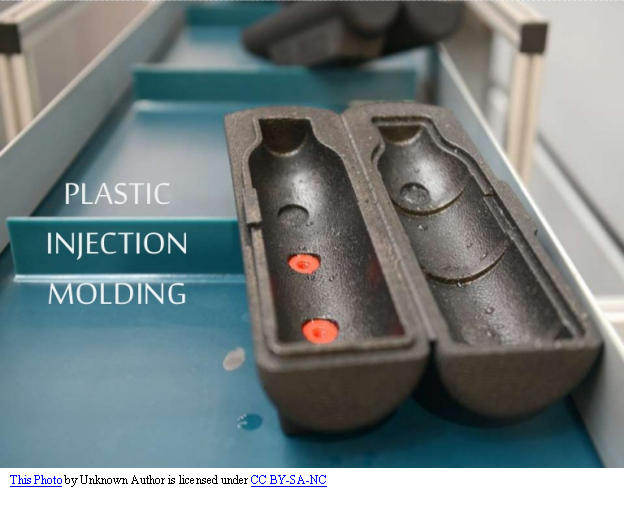When talking about the most common defects in the plastic manufacturing industry, injection molding flash is the first name that comes to mind. A thin plastic film that manages to escape from the mold is called a flash. This is basically the excess material that is forced out of the molding machine.
There are several reasons that lead to injection molding flash. In the same way there are several ways to prevent and fix it. This blog covers all such aspects with detail and precision.
What is injection molding flash?
Injection molding flash is simply a defect in the injection molding process. Plastic injection molding flash means the existence or occurrence of an excessive layer of plastic on injection molded parts.
This excess plastic occurs in the mold cavity where there is a parting line. Other than the parting line it occurs where two regions or shapes of the mold cavity join with each other.
Existence of injection molding flash in the injection molding process is mandatory. If you want to avoid it than you should buy premium quality injection molds. This increases the overall cost of the injection molding process.
Therefore, manufacturers need to look for ways to produce flash that create a break even between cost, process efficiency and the aesthetics of the product. If they want to maintain quality keeping manufacturing cost minimum than they have to devise ways to reduce the impacts of injection molding flash.

What Causes Injection Molding Flash?
1.Insufficient clamping force
During the injection molding process the accumulation of air inside the mold cavity is a common situation. However improper venting keeps the compressed trapped air inside the mold cavity. The pressure equilibrium inside the injection molding machine gets disturbed. This leads to molten material shrinkage.
There are many reasons behind improper venting. One such reason is the presence of old and worn out vents. The allow too little air to flow out. This causes trapping of compressed air inside the mold.
2.Low clamping pressure
During the injection molding process, it is mandatory for the mold closed tightly. For this you require a heavy external force. This external force is known as clamping pressure.
In case of an inadequate clamping pressure the internal pressure inside molded part of the molt causes it to remain open. Even the presence of a perfect parting line doesn’t matter in this case.
This is how low clamping pressure can be a reason behind the injection pressure and molding flash.
3.Low viscosity
Molten plastic with low viscosity is of course thin in texture and flow. It can easily come out of the mold. Several factors contribute to the increase in the plastic viscosity. These are mostly the factors related to the processing conditions such as:
- Increase in nozzle temperature and barrel temperature.
- The pressure inside the nozzle and the barrel.
- Residual moisture as a result of inadequate drying.
- Excessive use of cooling agents in the process.
The increased nozzle temperature and barrel temperature cause a decrease in material viscosity. This makes the molten plastic material runnier causing it to flow outside the mold.
4.Parting line mismatch
Parting line mismatch is a very common issue that causes injection molding flash. This type of error occurs when environmental contaminants create debris inside the injection mold that halves keeping the mold open. Flash defect occurs when the molten plastic material comes out of the mold. Issues in the design of molds and use of worn lout tool can all lead to parting line mismatches.
5.Overfilling the Mold
Some molds have complex designs. The creation of these complex designs requires that plastic flows through narrow and intricate pathways inside the molds. As the molten plastic flows through these narrow pathways some plastic solidifies inside them. This led to the creation of localized pressure inside causing injection molding flash error.
How to Prevent Flash in Injection Molding?
Flashing causes a lot of functional and aesthetic issues in molded parts. Therefore, prevention of injection molding flash is necessary. Following preventive measures can cause reduction on the error:
1.Design for Manufacturability
Design for manufacturability is the most effective measure to prevent injection molding flash in molded parts. But what does design for manufacturability mean?
It means designing the mold in a simple pattern that ensures effective and easy manufacturing process. A lot of manufacturers create complicated and intricate mold features which later become the reason for defects and errors.
In simple words design for manufacturability means creating simple mold designs.
Design for manufacturability or DFM has several potential advantages. These include:
- Reduction in manufacturing costs
- Short manufacturing time
- Assurance of highest quality possible
Implementation of DFM helps in meeting several parameters of injection molding process. These include:
- wall thickness
- ideal injection molded gate design
- mold parting line design
- hole design
Adherence to DFM reduces the probability of injection molding defects. DFM hold importance in prototype injection molding. Remember the more features you add the manufacturing cost increases.
2.Slow Down the Injection Rate
Another preventive measure to minimize flash is slowing the injection speed and down the injection rate. Why?
The reason is simple.
As you slowly inject the molten plastic the inside pressure of the mold remains low. Faster injection of material causes an increase in molding pressure.
This increased pressure can be the reason of plastic injection molding flash. The first injection stage is therefore very important. The prevention of injection molding flash can be avoided from the initial injection stage.
3.Specify a Flash-Free Mold
Flash free molds are available and they are the most convenient option to avoid injection molding flash. It is because:
- They have high injection molding tolerance.
- They have the ability to create aesthetically pleasing intricate designs and patterns.
- They guarantee best results.
- They minimize the probability of injection molding flash.
However, they are very expensive and therefore a lot of manufacturers are unable to afford them.
4.Proper Mold Cleaning
Using clean and properly maintained injection molding services can eliminate flash in injection molding. You can use several materials and tools for cleaning purposes. These include:
- clean rags
- mold cleanser
- compressed air
Another preventive measure is to properly clean the mold before initiating the injection molding process. Effective cleaning helps in removal of any contaminants or debris that might be present inside the mold. Failure to proper cleaning can cause injection molding flash. It is because these contaminants prevent the injection mold flash part from closing properly.
Close examination of the mold before starting the injection phase of the process is very important. It will help in identification of any plastic fragments. Often small plastic resin or fragments are present hidden behind slides and leader pins pockets.
5.Proper Mold Maintenance and Process Improvements
Inadequate processes and poor maintenance are the reasons why flash occurs. Often poor force exertion and clamp tonnage are the reasons behind mold damage. For the purpose of removing flash make sure that force is applied on the proper side of the mold. Inadequate or improper force and clamp damage can both damage molded parts.

How to Fix Injection Molding Flash?
Now that we have learnt about the causes and preventive measures behind injection molding flash, it is now time to learn about fixing it. The following remedies are most effective in fixing and removing flash other injection molding defects.
1.Using Hot Air
Using hot air for the removal of flash is a convenient method. However, it is suitable only in case of small flash that is thin and smooth. The mechanism is simple. The hot air melts the flash back into plastic form.
In case of hard and big sized flash this method is not recommended. It is because it effects the surface finish and overall look of the product.
2.Cryogenic Deflashing
If you are looking for a flash removal method that does not affect the surface finish of the product irrespective of the flash size than cryogenic deflashing is the answer. The mechanism of this process is very simple. It uses liquid nitrogen to cool down the flash part. The cooling process continues until the flash part is easily removable.
The main advantage of this process is that it does not impact the surface finish of the product. However, it does have one major limitation. It is that the deflashing machine is quite expensive. Not all manufacturers can afford it.
3.Manual Deflashing
Manual deflashing as the name indicates involves flash removal by hand. However, it does involve the use of deflashing tools such as:
- scissors
- knives
- grinders
What makes this deflashing process is the fact that it is versatile. The effect on surface finish depends upon the process variables the expertise of the operator.
However, this is the most commonly used deflashing method by engineers in manufacturing industries. All the flashes that exist along the parting line of the product get removed through this process.
4.Using Open Flame
As the name indicates this process uses open flame to remove flash. However, it is not highly recommended. It is because it has the threat to damage the surface finish of the final product. Also, if the product needs painting afterwards than this process makes the product miss fit for it.
Conclusion
No matter how perfect you make the product the presence on a single flash can ruin the whole product. As a manufacturer if you do not want to compromise your product quality while keeping the manufacturing cost low make sure that you follow all preventive measures.
This blog explains all the methods to prevent injection molding flash. It also mentions how you can fix it. You have to explore the most suitable method that can help you fix the defect without compromising the product’s surface finish.

